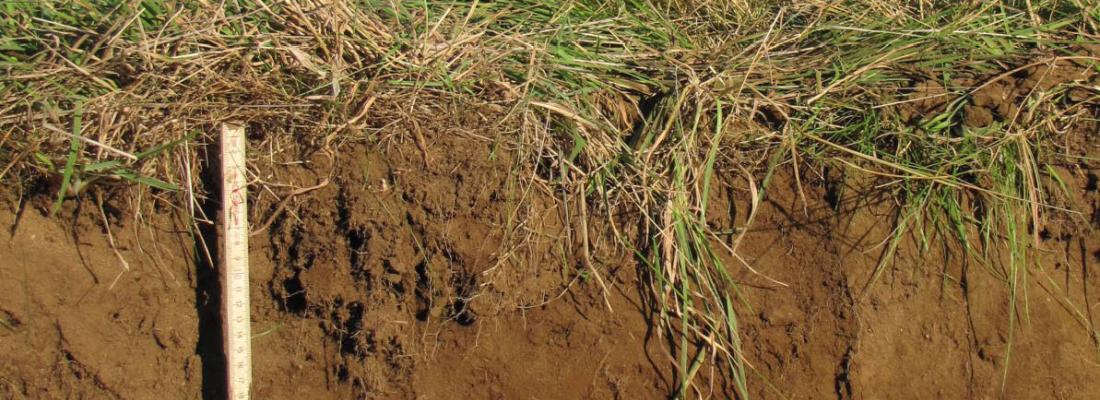Agroecology Reading time 4 min
The rate of soil carbon turnover: a matter of depth
Published on 12 July 2018

With 1,500 gigatonnes of carbon, double the amount found in the atmosphere and vegetation combined, soils are one of the biggest carbon reservoirs on the planet, at the center of the terrestrial carbon fluxes system. Through the process of photosynthesis, plants fix carbon from the atmosphere’s CO2 and incorporate it into the soils in the form of root exudates and residues. This carbon is stored in the soil for varying durations, before being transformed again into CO2 through the respiration of organic-matter decomposers. The continuous exchange of carbon between soil and the atmosphere helps to regulate CO2 content in the atmosphere, which in turn regulates the climate, and could even affect productivity in agroecosystems. All of these factors illustrate the importance of improving our understanding of soil–atmosphere carbon exchange in order to appreciate its consequences.
With the help of a meta-analysis, scientists from INRA, CEA and CNRS1revealed that no less than 25% of soil carbon was renewed within the past 50 years, with a small but significant contribution from deep soil layers.
An unprecedented representation of soil carbon dynamics
Through the observation of stable carbon isotopes, the team conducted their own measurements, which, together with data from around 50 scientific studies, helped them to determine the residence time and the vertical-depth distribution of vegetation-derived carbon from the soil of 112 grasslands, forests, and croplands from around the world.
They concluded that, between 1965 and 2015, the mean turnover of soil carbon was 0.5 percent per year. Approximately 80% of the young carbon—less than 50 years old—is found in the topsoil (0–30 cm), while the remaining 20% is found in deeper soil layers or subsoil (30–100 cm). Carbon incorporation in subsoil is the result of interacting processes: the fauna mixes the soils (known as bioturbation) down to around 70 cm deep, the roots carry carbon down to two metres deep, and organic-matter decomposers, as their name suggests, contribute to the decomposition of other organisms, a process that weakens with depth.
As a result, we observe a strong vertical gradient in carbon dynamics, which the researchers measured throughout the tropical zones—where the average carbon age goes from 7 years, on the surface, to 1,250 years, one metre deep. In general terms, they concluded that the dynamics of topsoil carbon (0–30 cm) is around seven times faster than that of subsoil carbon (30–100 cm).
The impact of climate and land use on carbon dynamics
Croplands incorporate less new carbon in the topsoil than forests and grasslands do, mainly because of crop harvests. However, this study shows that the amounts of carbon that they incorporate in their subsoil are relatively larger, since 30% of young carbon is found in the deeper layers (30–100 cm).
In general terms, 50% of the new carbon is incorporated between 0 and 10 cm deep, while the remaining 50% is incorporated beyond that point. The median depth goes from 9 cm in forests to 17.5 cm in croplands, which highlights the impact of land use, especially agricultural activities, on carbon incorporation.
In temperate croplands, organic carbon is old, around 75 years old, even in the topsoil, which means that the organic matter of soils today is the result of the work of several generations of farmers.
Researchers pointed out that, in the deeper soil layers, carbon age does not depend so much on temperature as on precipitation: it tends to be younger in dry climates, due to deeper rooting.
The study’s findings on the depth dependent dynamics of soil-atmosphere carbon exchange have proven to be crucial. They will allow more realistic projections of the carbon cycle evolution, a more accurate assessment of carbon content in soils, and a better understanding of the factors responsible for the variation in carbon stock, among different zones and due to different land uses. Soil organic carbon management is vital for productivity and sustainability of agroecosystems, the environment, and even public policies; it must be long-term for future generations and take subsoil carbon into account.
This research was carried out within the framework of the project DEDYCAS –Depth-Dependent Dynamics of Carbon in Soils: new concepts, measurements, and modelling (French National Research Agency – ANR, 2015-2018).
1 With the participation of the following research units:
• European Centre for Research and Teaching in Environmental Geosciences (CEREGE) Aix-Marseille University, CNRS, IRD, INRA, Collège de France
• Fruit and Vegetable Genetics and Breeding Unit, INRA
• Research Unit for Forest Ecosystem Biogeochemistry, INRA
• Laboratory for Sciences of Climate and Environment, CEA, CNRS, Université de Versailles Saint-Quentin-en-Yvelines (UVSQ)
Atmosphere-soil carbon transfer as a function of soil depth.
Jérôme Balesdent, Isabelle Basile-Doelsch, Joël Chadoeuf, Sophie Cornu, Delphine Derrien, Zuzana Fekiacova, Christine Hatté. Nature (2018) www.nature.com/articles/s41586-018-0328-3
